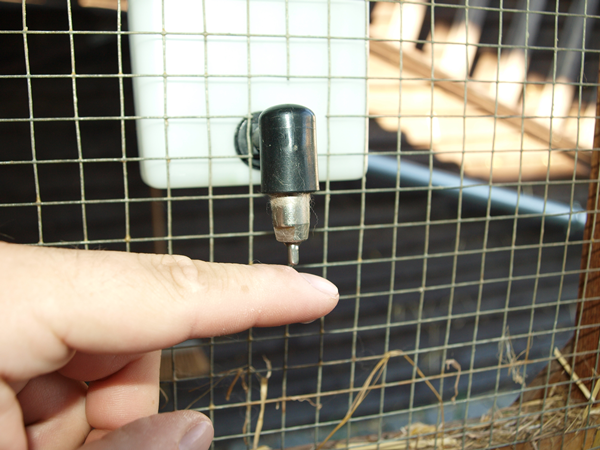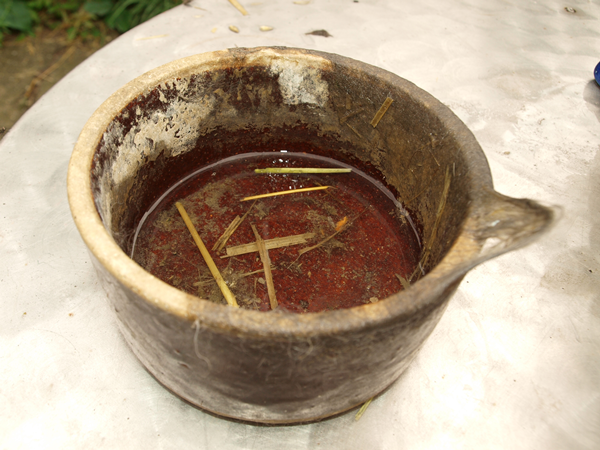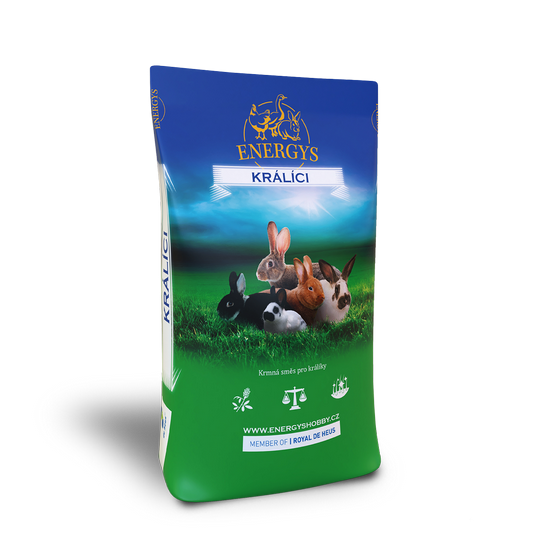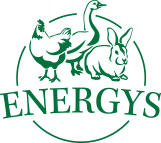Rabbits
Poultry
Laying hens
Quails
Guinea pigs
Pigs
Ostriches
Sheep and goats
Pigeons
Pheasants
Forest animals
Hygiene, feeding and water during the year
The feeding and watering technology needs to be protected against adverse weather conditions throughout the year. Poor care for the technology may lead to health problems and/or reduced effectiveness of rabbit breeding.
Water
- Bowls
They are the most natural, the simplest and probably the cheapest technology for giving water to rabbits. They like to drink water from a free pool of water and bowls are a suitable solution especially in young animals or newly arriving rabbits. They are made from various types of materials – from earthenware and sheet metal to the “virtually unbreakable” commercial resin. The important thing is that rabbits do not tip their bowls over or tend to jump into their bowls. Fast soiling of water is a disadvantage of this solution and this can be a problem especially in young animals or during the summer period. Frequent exchange of water is therefore essential because water contaminated with bedding material, feces or urine is unusable for rabbits. Bowls must be cleaned regularly with a brush to remove algae and disinfection at least twice a year is recommended. Hairs tend to accumulate on sides of bowls especially with long-haired breeds of rabbits. These must be removed regularly. During the winter period, bowls in outdoor rabbit hutches need to be defrosted in hot water as needed (and then lukewarm drinking water approximately one half of the volume must be given to the rabbits).
- Drinkers
Drinkers eliminate the possibility of external contamination of the drinking water by rabbits and thus ensure stable satisfactory quality of the drinking water longer term. There are many different models of external hanging drinkers. They differ mainly in the design of the end piece for rabbits drinking.
The original water surface drinkers are not suitable for rabbits due to easy contamination of water.
The older ball types are less suitable due to easier dripping and the fact that the container needs to be unscrewed when replacing water.
Nipple (pin) drinkers are significantly better in this regard. They have a more solid structure and are easier to clean.
What is generally true for both types? Drinkers should be dismantled completely at least four times a year and algae in the container should be cleaned, as algae always appear after a prolonged period of time. Products for adjusting the pH value of drinking water that limit the growth of algae are currently available on the market. Accumulated hairs appear over time on the end pieces of drinkers with long-haired breeds and with older animals and these need to be removed – firstly to ensure the correct functioning of the drinker (a risk of gradual dehydration of rabbits!) and to eliminate the occurrence of hairballs in the stomach (i.e. tufts of hairs in the digestive tract). In addition, checking nipples regularly is recommended especially to ensure that water does not flow freely from the nipple (risk of very moist air and bedding material) or that the nipples are not hardened with scale, algae or other foreign matter (dehydration!).

Image 1 – Regular checking of functional nipple
- Central watering system
Central watering systems comprise of a container (connected to water mains), distribution hoses and end pieces – nipples that deliver water to individual pens. While this solution is the least demanding on the rabbit keeper’s time, it is also the most expensive option. Even in this case rabbit keepers must check nipples regularly. In addition, scale tends to accumulate gradually in bends of the distribution hoses and these also need to be checked.
Feeding
- Bowls for grainy fodder
These come in different shapes and sizes. They are intended for giving concentrated fodder to rabbits. These bowls are made from the same materials as water bowls. The use of the so-called double bowls has proven to be practical, as one bowl is used for grains and the second bowl for water. This leads to fast contamination of water and fodder and the consequent health risks.

Image 2 – Bowls and drinkers must be cleaned regularly from stuck hairs and other dirt
- Containers
These are not suitable for rabbits.
- Feeding bulky fodder
While rabbit pens have customarily been fitted with racks for hay for decades, this is not necessary as long as the basic pen hygiene is maintained. If the bedding material is replaced frequently, hay/straw can be placed on the pen floor or on the so-called landing.
Related posts
10. April 2024
Keeping dwarf rabbits as pets is becoming increasingly popular. It does not require a lot of space and is ideal for people who live in smaller homes or apartments. Dwarf rabbits are also very friendly, so it’s no wonder that people are choosing them for this purpose more and more often. As with all animals,…
30. August 2022
In this article we will discuss several rabbit diseases – ear scab, tyzzer’s disease and heat stress.
24. August 2022
In this article we look at two diseases – e.Coli and enterocolitis.
2. August 2022
In this article we look at two common rabbit diseases, myxomatosis and infectious rhinitis.
13. July 2022
In the following article we will discuss rabbit plague – rhd or vhd (viral haemorrhagic disease of rabbits).
Related products

RABBIT DWART
Complete pelleted feed for dwarf rabbits with high digestibility. It contains a high proportion of fibre (high alfalfa and grass cake content) and a reduced sugar and starch content. Contains flaxseed, which has a positive effect on coat quality. Suitable for daily feeding. We recommend providing rabbits with safe fresh water and hay.

RABBIT CHAMPION
Feed for show rabbits, does not include Coccidiostat. A unique mix significantly supports the quality and growth of fur. Serve when moulting and at least two months before the start of the show season.

RABBIT GOLD FORTE
A premium feed mix in an ideal make up for gestating and breast feeding females. For the intensive fattening of rabbits for a period of up to 5 days before slaughter. It supports fast growth, meat content and an excellent state of health. It contains a coccidiostat which lowers the risk of mortality.

RABBIT KLASIK FORTE
Intended for the fattening of rabbits up to a point at least 5 days before slaughter. Suitable for attaining a high meat content and an excellent state of health. Thanks to its Coccidiostat content it lowers the animals mortality.

RABBIT KLASIK
For the final phase of rabbit fattening, a minimum of 5 days before slaughter. It supports high meat content and excellent taste qualities in rabbit meat. Without a coccidiostat.

RABBIT START
For young rabbits from the start of accepting feed to 4-6 weeks after weaning. The feed helps to significantly lower the death rate in the period around weaning. It contains a raised percentage of fibre and less starch. It does not contain a coccidiostat.
